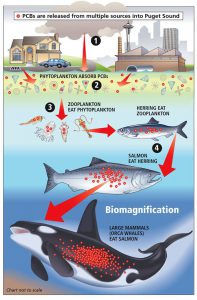
Bioaccumulation and biomagnification are two different processes that often occur in tandem with one another. Bioaccumulation is the process by which toxins enter the food web by building up in individual organisms, while biomagnification is the process by which toxins are passed from one trophic level to the next (and thereby increase in concentration) within a food web.
 Photo credit: www.mercurypolicy.scripts.mit.edu
Photo credit: www.mercurypolicy.scripts.mit.edu
Synthetic (man-made) chemicals called Persistent Organic Pollutants, or POPs, are of primary concern when looking at bioaccumulation and biomagnification. These chemicals do not easily break down in the environment and can build up in the fatty tissues of living organisms. Some examples of POPs you may have heard of include DDT (an insecticide that was used extensively post-WWII) and PCBs (flame retardants). Although the production of these chemicals was banned during the 1970s and 1980s, they can still be found in the oceans as well as the tissues of many marine animals because of their ability to (1.) persist in the environment for long periods of time, (2.) move within water, and (3.) dissolve into the fatty tissues of living organisms. For all of these reasons, POPs like DDT and PCBs are especially good at bioaccumulating and biomagnifying.

Bioaccumulation occurs at the base of a food web, usually within primary producers like phytoplankton. These microscopic photosynthetic organisms absorb POPs directly from the seawater and accumulate them in their bodies over time. The toxins build up in their tissues because they are absorbed from the water at a rate faster than they can be metabolized.
Biomagnification occurs when slightly larger organisms called zooplankton feed upon the contaminated phytoplankton and in turn absorb POPs into their own tissues at a higher concentration. The more contaminated phytoplankton a zooplankton eats, the more pollutants it will have in its body. In other words, the POPs can be passed from producer to consumer (to consumer, to consumer, and so on…) Biomagnification can continue all the way up the food web or chain. Because the amounts of POPs become more and more concentrated at each trophic level, some of the ocean’s apex predators are at risk of gaining potentially fatal levels of POPs within their bodies.
One large apex predator that is heavily impacted by the bioaccumulation and biomagnification of POPs is the orca. Researchers have found extremely high levels of PCBs within the blubber of Arctic orcas, making them “the most toxic animal in the Arctic.” Additionally, scientists in Japan have found that mother orcas are passing these contaminants to their young through their milk, which has high fat content. PCBs are known to cause problems with reproduction, and studies are currently being conducted to see if and how POPs are impacting orcas in other ways.
Governments are slowly starting to realize the importance of countering the negative impacts of these pollutants. The production of DDT was banned in the United States in 1972, and more chemicals are being banned each year. In 2004, the Stockholm Convention on Persistent Organic Pollutants came into effect and internationally bans the production of PCBs and other harmful chemicals. These bans have proven to be mostly effective, and the environmental levels of many of these toxins have already started to noticeably decrease.
Sources:
http://rstb.royalsocietypublishing.org/content/royptb/286/1015/483.full.pdf
https://www.epa.gov/sites/production/files/documents/bioaccumulationbiomagnificationeffects.pdf
http://w3.marietta.edu/~biol/102/2bioma95.html
http://news.nationalgeographic.com/news/2005/12/1213_051213_killer_whales.html


